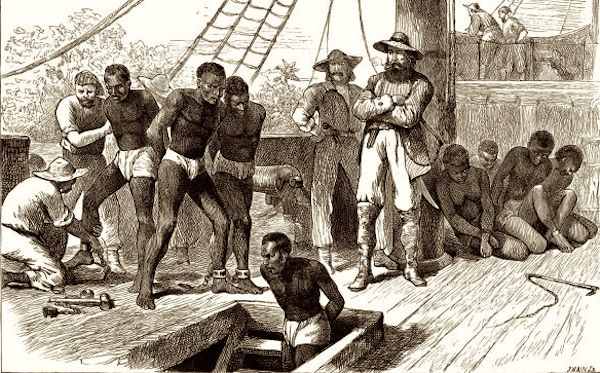Your cart is currently empty!

Raw Text
“Some slave owners sought to maximize their profits by skimping on the provisions that were given to slaves. Many slaves were expected to live by the old southern adage ‘root, hog, or die,’ which implied the slave was left to his or her own devices to find nourishment. Such circumstances often drove the slave toward small acts of resistance that were carried out with the aim of acquiring more food. As such, the idea of resistance as learned behavior that was inspired by purposeful mistreatment begins to take shape. Slave owners may have deplored slave resistance, but their poor management practices often served to foment such behavior.
Starvation was also one of the most brutal means of punishing the most recalcitrant slaves. At Elmina Castle on the Gold Coast of Africa (in modern day Ghana), those Africans held in captivity sometimes rebelled before thy were placed aboard slave vessels to be shipped to the Americas. For the most egregious offenders, a special cell was set aside where the insurrectionists would be jailed in solitary confinement until they starved to death. The muffled screams and howling cries of those who endured the painful death of starvation were clearly designed to be reminders to all other captives of what fate befalls the rebel.
Whether it was a means of resistance itself, an impetus for further resistance, or the ultimate punishment for those who chose to resist, starvation was a condition that was known to the slave and occasionally witnessed. Many of the slave narratives make clear the presence of hunger in slave life and the means of resistance that were employed to counter it. For some, and the means of resistance that were employed to counter it. For some, starvation was a form of ritualistic suicide, a slow and painful way of resigning oneself to a life in bondage…” – Junius P. Rodriguez, Encyclopedia of Slave Resistance and Rebellion, Volume 2, pp. 484-485
MDL Analytical Memoing
Note, Labor is applicable to all work, professional or non-professional. For the purpose of this MDL analysis, all expenditures of energy contributing to production/service are included.
| “Some slave owners | [labor unit controllers] | ||||
| sought to maximize their profits | [to]maximize[d] profits | sought accelerating growth |
increase in growth steepness | peak acceleration is [redacted] | brachistochrone curve from present state to infinite growth |
| by skimping on the provisions that were given to slaves. | [to]skimp[ed] [nourishment] given to [labor units] |
sought decelerating maintenance |
decrease in maintenance steepness | floor maintenance is Zero | brachistochrone curve from present state to zero maintenance |
| slave was left to his or her own devices to find nourishment | [labor units] left find own [nourishment] | empathy neglect | |||
| drove the slave toward small acts of resistance that were carried out with the aim of acquiring more food | drove [labor units] toward resistance [nourishment acquisition] | obstruction navigation | |||
| idea of resistance as learned behavior | resistance learned behavior | ||||
| that was inspired by purposeful mistreatment begins to take shape | [labor units] inspired by [planned nourishment withholding] |
purposeful mistreatment proportional to learned resistance behavior | proportional to independent acquisition of nourishment | ||
| Slave owners may have deplored slave resistance, but their | [labor unit owners] deplored labor unit resistance | increases maintenance costs | |||
| poor management practices often served to foment such behavior. | [saturation] [labor units] inspired by [planned nourishment withholding] |
||||
| Starvation was also one of the most brutal means of punishing the most recalcitrant slaves. | [saturation] [labor units] inspired by [planned nourishment withholding] |
||||
| At Elmina Castle on the Gold Coast of Africa (in modern day Ghana), those Africans held in captivity sometimes rebelled before thy were placed aboard slave vessels to be shipped to the Americas. | [labor units] [resistance] before [labor unit harvesting] |
||||
| For the most egregious offenders, a special cell was set aside where the insurrectionists would be jailed in solitary confinement until they starved to death. | most egregious [labor units][resistance] [isolated][nourishment flooring] | [labor unit] resistance asymptotic proportion to isolative [nourishment flooring] | |||
| The muffled screams and howling cries of those who endured the painful death of starvation were clearly designed to be reminders to all other captives of what fate befalls the rebel. | [isolation] [pain][marketing] [deterrent] [targeting resistance audience] |
||||
| Whether it was a means of resistance itself, an impetus for further resistance, or the ultimate punishment for those who chose to resist, starvation was a condition that was known to slave and occasionally witnessed. | [planned nourishment withholding] condition known to [labor units] | ||||
| Many of the slave narratives make clear the presence of hunger in slave life and the means of resistance that were employed to counter it. | [saturation] [planned nourishment withholding] condition known to [labor units] & resistance learned behavior |
||||
| For some, and the means of resistance that were employed to counter it. For some, starvation was a form of ritualistic suicide, a slow and painful way of resigning oneself to a life in bondage…” | [planned nourishment withholding] [acceleration toward] [nourishment flooring] [resignation] to [inescapable] [labor unit control] |
And the sign flashed bright in neon pink lights against the deep blue evening sky speckled with stars, and it sizzled brightly:
Solution Found
MDL Memos
[redacted]
substitute human capital for labor unit
